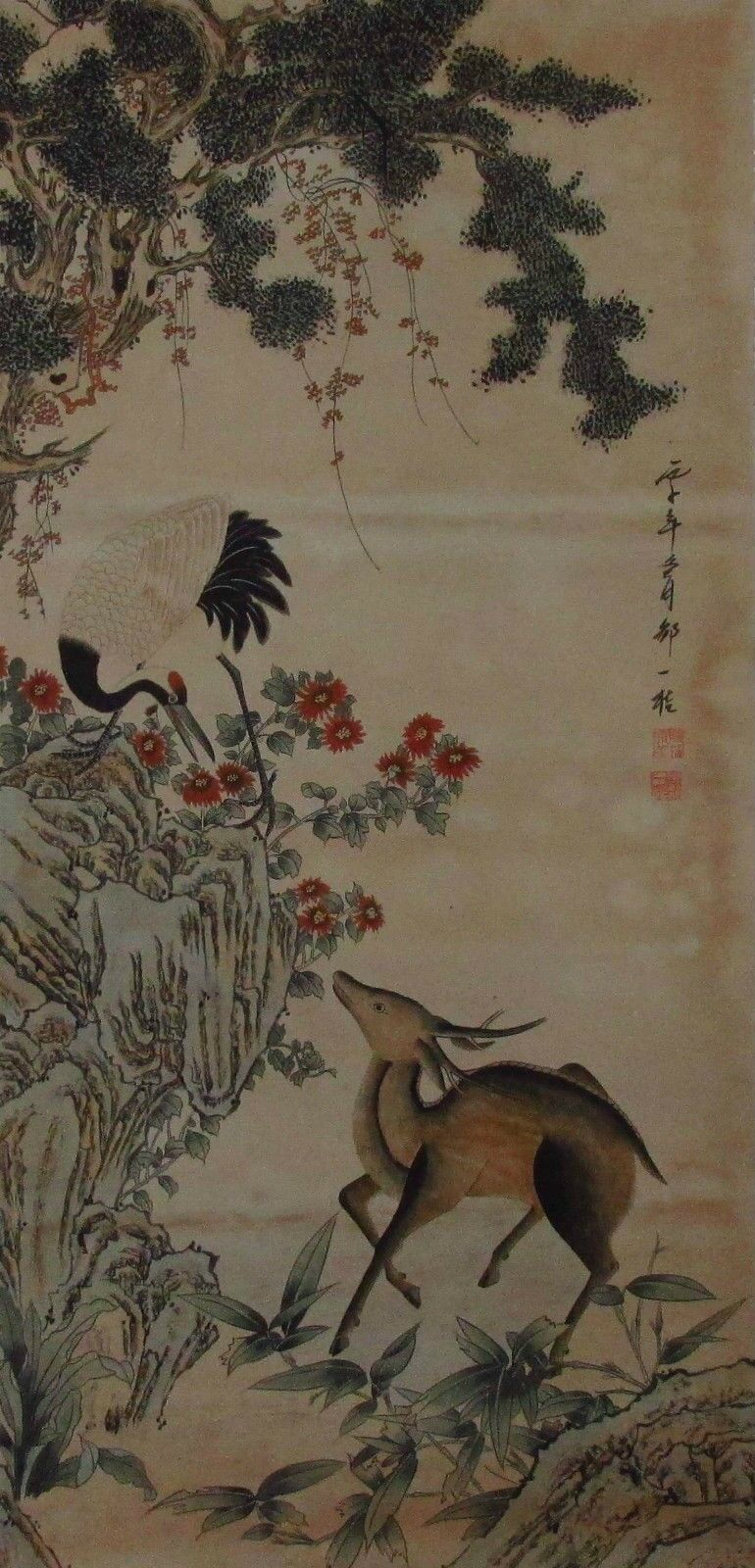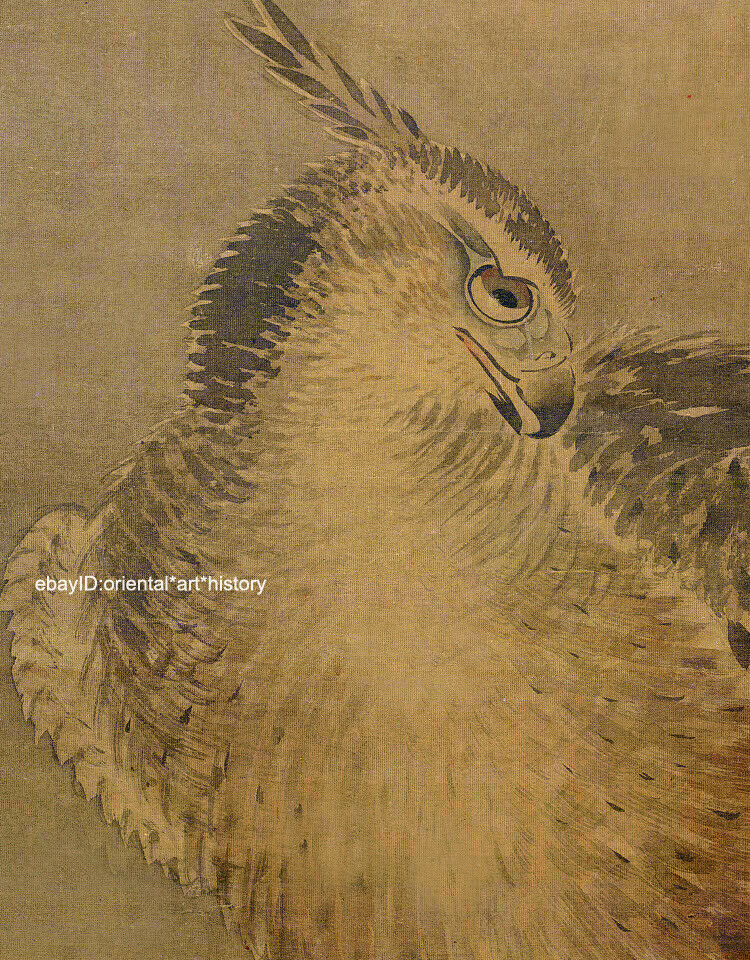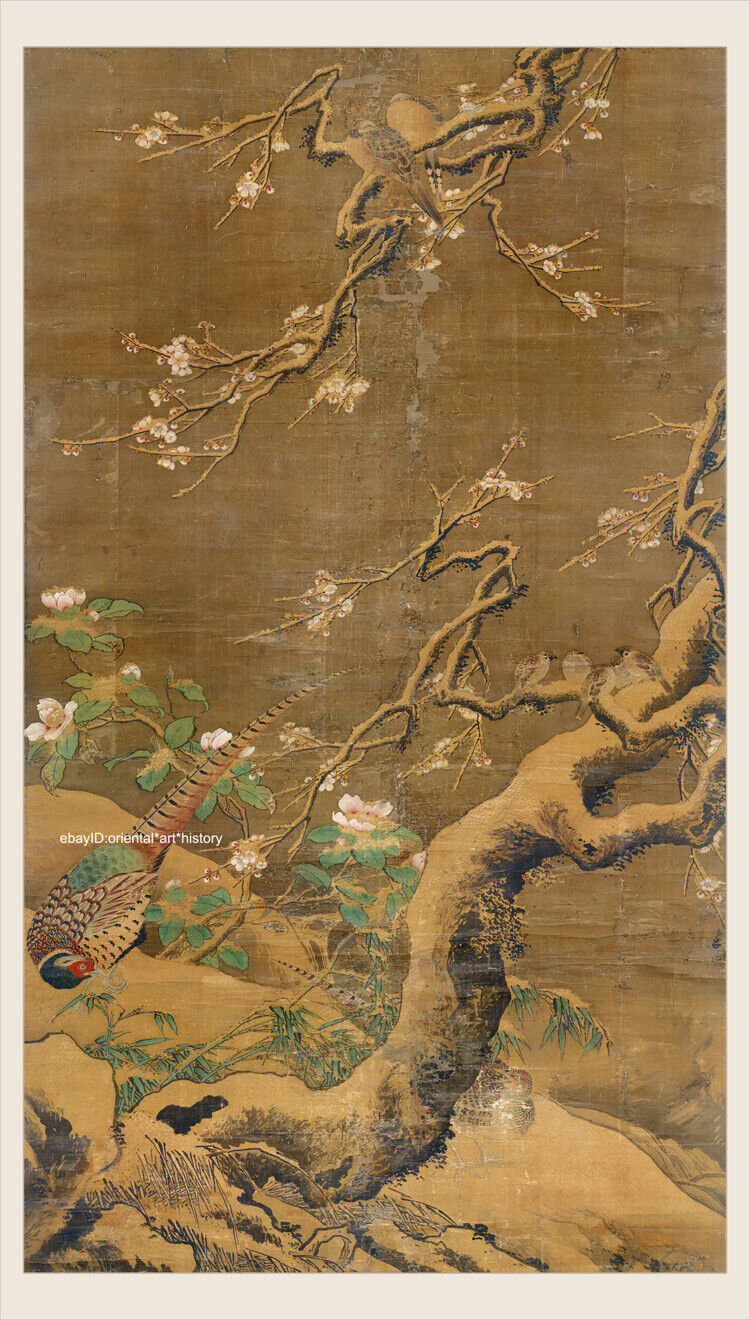-40%
Qing Dynasty 5' Hanging Scroll Crane, Deer, & Pine Trees. Zou Yigui (1686-1772)
$ 1570.8
- Description
- Size Guide
Description
Ancient CivilizationsAntiques, Artifacts & Fine Collectibles
RARE
18
th
Century Chinese Hanging Scroll Painting
Features:
Deer, Pine Tree & Red-Crowned Crane
Symbols of Longevity, Immortality, and Wealth
The “Crane of the Immortals” (
Xiānhè
)
Qing Dynasty
by
Chinese Master
Zou
Yigui
(1686-1772)
"It is like clouds and mists passing before my eyes, or the songs of birds striking my ears. How could I help but derive joy from my contact with these things?
But when they are gone, I think no more about them. In this way, these two things [painting and calligraphy] are a constant pleasure to me, but not an affliction."
-- Su Tung-p'o, 11th century statesman, poet, and connoisseur, on collecting.
Translation by James Cahill
Item:
Chinese Hanging Scroll Painting of Red-Crowned Immortal Crane and Deer
Material:
Silk & fabric
Scroll Size:
60” (153 cm) x 21” (54 cm)
Painting:
34” (87 cm) x 16.6” (42 cm)
Origin:
China; Qing Dynasty
Artist:
Master Zou
Yigui
(1686-1772) Signed and Sealed
Zou Yigui (simplified Chinese:
邹一桂
; traditional Chinese:
鄒一桂
; pinyin: Zōu Yīguì; Wade–Giles: Tsou I-kui) (1686–1772), style name as Yuanbao (
原褒
), sobriquet as Xiaoshan (
小山
) and Erzhi (
二知
), is a famed Chinese painter in Qing Dynasty. He was born in Wuxi, Jiangsu Province.
He painted for the imperial family, skilled in painting flowers in minutes ways. He was also talented in painting landscapes. He once wrote a book named "
Art of Painting of Xiaoshan
" (
小山画
谱
), discussing the experience of painting.
Handscroll--ink and mineral pigments for color on silk
Provenance & Condition:
This painting was in a private collection in LuoYangShi, Henan, China, and then an ex private collection in Hong Kong.
This scroll was purchased at auction and this is the first time it has been for sale in the United States.
Condition:
This scroll is in very good, period condition with no major repairs of restorations.
Two red seals (chops) are affixed to both the painting that serve as Master
Yigui
signature.
The painting shows age appropriate toning and some old moisture stains near the artist’s signature, but they do not affect its integrity or the price.
Within the last 20 years or so, this 18
th
century painting appears to have been expertly remounted on a fabric/silk backing to protect this classic work.
The new backing allows this scroll to be hung, but at over five-feet long, it is best viewed as a handscroll to enjoy its beauty and to protect the delicate painting from light, wear, and moisture.
DETAILS
This precious scroll was painted by Chinese Master Zou Yigui (1686-1772), who is one of the most famous and prolific painters during the glorious Qing Dynasty.
His extraordinary works can be found in the finest museums in the world.
Only rarely, does one of his handscrolls come on the market for private collectors to enjoy the fantastic emotional power and beauty of his work.
This scroll has been in private collections in China for about 300 years and this is the first time it is being offered for sale in the United States.
Master Yigui
was innovative in his paintings in that he focused of “acuity perspective,” which describes how objects far away become less distinct.
Notice how the pine needles in the foreground and detailed, sharp, and clear, while those needles in the background appear blurry and out of focus.
This style creates a wonderful sense of death of field.
Perhaps Leonardo da Vinci described it best in the 15
th
century when he stated:
“You must diminish the sharpness of those objects in proportion to their increasing distance from the eye of the spectator.
The parts that are near in the foreground should be finished in a bold, determined manner; but those in the distance must be unfinished and confused in their outlines.”
Ref.
Walter Isaacson,
Leonardo da Vinci
, 2017, pg. 275
Symbolism of Chinese Deer
In China, deer are known for their speed, grace, endurance and long life.
Deer are graceful, lovely animals that are thought of as symbols of longevity and wealth in Chinese culture.
Phonetically, the Chinese word for deer sounds like the Chinese word for “
luk
” which also means good income and prosperity.
It is the auspicious emblem of long life because deer is the only animal which can find the “
leng tzi
”, the fungus of immortality.
Its horns can be used to make medicine and have medicinal values. Being known as wealth enhancers and symbol of longevity, these beautiful creatures represent long-lived wealth and long-term prosperity. Shou Xing Gong (the Chinese God of longevity) is also seen accompanied by a deer to symbolize the trinity blessings of wealth, good fortune and longevity.
Notice that the artist shows in detail how the deer has eaten the tender ends off some of the bamboo green leaves nearest the ground.
In
feng shui
, many experts think of deer as appropriate symbols for the east part of the garden or the east sector of the house where they enhance the health-related properties of the east. As a form of auspicious symbolism, the feng shui deer can also be placed in the wealth sector of your office to enhance business luck, job income and promotion prospect.
Displaying deer in a business will signify a company that grow and prosper for many years.
Red-Crowned Cranes in Ancient China {Ref:
Wikipedia}
There are four types of cranes in Chinese myth: white, yellow, blue and black. The black crane is thought to live the longest - up to 600 years. When a crane is shown among clouds it stands for longevity, wisdom and nobility. When shown among pine trees, as in this lovely scroll, the crane symbolizes determination, wealth and power. When two cranes are shown together, it is the ultimate depiction of longevity.
In China, the red-crowned crane is often featured in myths and legends. In Taoism, the red-crowned crane is a symbol of longevity and immortality. In art and literature, immortals are often depicted riding on cranes. A mortal who attains immortality is similarly carried off by a crane. Reflecting this association, red-crowned cranes are called
xian he
(traditional Chinese:
仙鶴
; simplified Chinese:
仙
鹤
; pinyin: xiānhè; literally: "fairy crane" or "crane of the immortals"). The red-crowned crane is also a symbol of nobility. Depictions of the crane have been found over 3,000 years ago in Shang Dynasty tombs and Zhou Dynasty ceremonial bronzeware.
A common theme in later Chinese art is the reclusive scholar who cultivates bamboo and keeps cranes. Some literati even reared cranes and trained them to dance to
guqin
music.
The Crane also symbolizes several positive attributes—it mates for life (loyalty), and flies high for miles without tiring (strength.)
This is reportedly why an image of the red-crowned crane is featured in the official logo of Japan Airlines.
Because of its importance in Chinese culture, the red-crowned crane was selected by the National Forestry Bureau of the People's Republic of China as a candidate for the title of national animal of China.
However, this decision was deferred due to the red-crowned crane's Latin name translation as "Japanese Crane.”
Pine Tree Symbolism in China
Because of their endurance, and steadfastness even in the harshest weather conditions, pine trees are honored Chinese symbols for long life.
The pine is often depicted in Chinese art with other symbols of longevity such as the crane and deer that are featured on this painting.
The rock outcropping also is a symbol of steadfastness in life’s hardships and perseverance.
Chinese Scroll Painting
There are four basic formats of Chinese painting: hanging scroll, handscroll, album, and fan. The scroll formats have been perfected over time to insure that when the scrolls are stored, they are resistant to light, insects and moisture. The painting or calligraphy is mounted to a paper backing that can be many layers thick.
Painting Scrolls
The colors used in traditional Chinese painting are all mineral pigments ground into a fine powder and suspended in a wet medium that makes colored paint. The minerals traditionally used include malachite for green, azurite for blue and cinnabar for red. These colors will never fade. They can be abraded away so that color appears to fade, but because the pigments contain ground stone they will never actually fade. This use of mineral pigments is the reason that many very old Chinese paintings, like this one shown here from the 17
th
Century, still have strong, vibrant colors.
The brush used in Chinese painting and calligraphy usually has a long handle made of wood or bamboo, while some fancy brush handles can be ceramic, jade or lacquer. Animal hairs in a variety of combinations are used. The tips can be long or short, thick or thin, stiff or soft, or stiff outer hairs can surround softer interior hairs – all depending on the desired effect.
Red Seals Stamped on Chinese Paintings
The red seals found throughout Chinese painting typically begin with the seal or seals of the artist. The artist usually places a seal or two immediately after the signature. On this scroll, Ch’en Hong-shou (1598-1652) has placed his seal on the opening part of the scroll (the front piece) and on the painting itself.
In other works by him, a different seal was placed somewhere on each picture. In some cases, it is the same seal throughout, but the artist might mix them up. The seals can have an artist’s name, nickname, style name, the name of his studio or a title he has received. The possibilities are endless.
The other red seals on this painting are those of collectors or contemporaries who once owned or viewed this amazing painting and admired it for stunning beauty. It is a strange concept to a Western audience to place one’s mark on the painting itself. Imagine a Van Gogh painting displaying the signature of everyone who has owned it. In the West, this simply is not done. But the Chinese have a very different perception of time and their participation in it, as well as the history of an object like a painting. For the art historian, seals are a record of provenance. They are invaluable tools for authenticating the history of a painting.
Seals themselves have been made from a number of different materials, including bronze and stone that require special skills to manufacture. During the Ming dynasty (1368-1644), a relatively soft stone, called soapstone, began to be used. This revolutionized the making of seals, as the artists themselves could begin to carve them. By the Qing dynasty (1644-1910), many artists carved great numbers of their own seals using a wide variety of character styles and names. In China today seals are still used by artists, but also by virtually everyone after the signature of any important document.
Remounting of Chinese Paintings on Scrolls
Within the last 30 years or so, this 17
th
century Chen painting appears to have been expertly remounted on a fabric/silk backing to protect this classic work.
The new backing allows this scroll to be hung, but it is best viewed as a hand scroll to enjoy its beauty and to protect the delicate painting from light, wear, and moisture.
Chinese scroll formats also allow for paintings to be remounted periodically – every 100 or 200 years, even longer depending on wear, storage conditions, etc. This is often a time-consuming process that requires all the layers of backing paper to be meticulously removed layer by layer until the painting proper is free from any backing. The painting is allowed to rest, and then new layers of backing are applied. This process can take many months, even up to year to complete. However, remounting will protect the painting for another long period of time.
ESTIMATED VALUE
Many experts consider
Master
Zou
Yigui
(1686-1772)
as one of the best Qing Dynasty painters. This amazing hanging scroll has an appraisal estimate of US ,000--,000.
It will come with a Certificate of Authenticity (COA).
Please examine the photos taken indoors carefully as they are part of the description.
And please ask any questions before you buy. Thanks!
Please ask any questions you may have before you bid! Thanks for Looking!
Per e-Bay's rules, PayPal only please! All Sales are Final!
THANKS!
FREE SHIPPING cost includes Insurance and is accurate for all 50 United States.
Sorry, but Washington State residents are required to pay the state sales tax. Thanks...



















